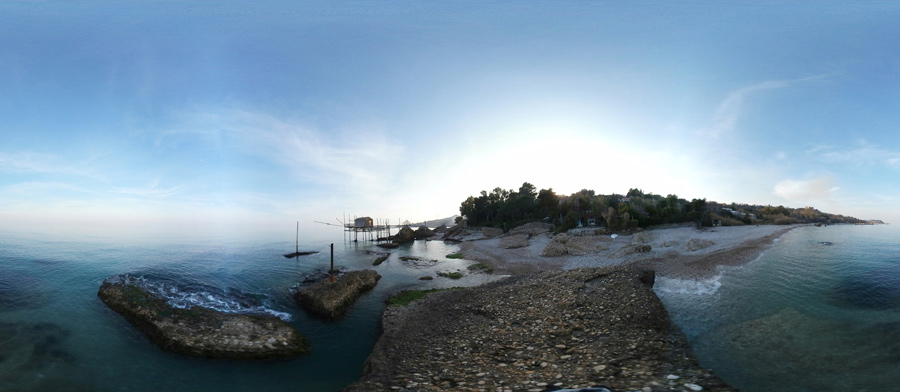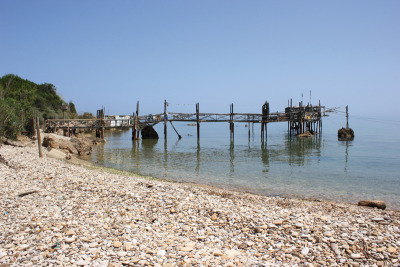Scogliera e trabocchi in località Canale
A due passi dagli orti rigogliosi, cui si alternano canneti, torrenti e valloni che degradano verso il mare, la
scogliera vastese da Trave, Casarza e San Nicola fino a Canale e Vignola, è una magia di calette, rocce e
ciottoli, una sequenza di vedute mozzafiato punteggiate dai “trabocchi”, le arcane macchine da pesca
descritte anche dal D’Annunzio protese su mille sfumature di blu dell’Adriatico. La costa abruzzese da
Ortona a San Salvo è chiamata "Costa dei trabocchi" proprio perché le caratteristiche palafitte usate per la
pesca con le reti sono una costante del paesaggio.
In località Canale, la bella spiaggia che si apre a ridosso delle sfumature del verde più intenso è delimitata
da due trabocchi. Osservandoli si ha l'impressione che debbano cedere al mare da un momento all’altro,
protesi sugli scogli per mezzo di passerelle, o con la rete agganciata a lunghi bracci e a bilanciere per
raggiungere senza barca punti dove l'acqua è più profonda e pescosa. Sono antichissime strutture che, pur
nella loro fragilità, da centinaia di anni resistono alle intemperie, silenziose vedette sul mare.
Tuttora i trabocchi emanano un fascino particolare, un fascino d'altri tempi. Grazie alla loro bizzarra
architettura accendono l'immaginazione e stimolano la curiosità. Secoli di vicende e intere vite di
pescatori raccontano i loro pontili, dove intere famiglie passavano più tempo che nella loro stessa casa.
Oggi, il trabocco, simbolo e sintesi della vita e delle tradizioni di un popolo, diventa anche fonte di
sviluppo per un turismo culturale.
Vasto
Reef and “trabocchi” of the Canale
A few steps from luxuriant gardens alternated with groves of reeds, torrents and deep valleys sloping to
the sea, the Vasto reef of Trave, Casarza and San Nicola up to Canale and Vignola, is a magical play of
bays, rocks and pebbles, a sequence of breathtaking views punctuated by the “trabocchi,” the archaic
fishing systems also described by D’Annunzio, extending over the Adriatic Sea’s thousand shades of blue.
The Abruzzo coast from Ortona to San Salvo is called the “Coast of the trabocchi" exactly because the
typical pile-dwellings used for net fishing are a stable part of the landscape.
In the locality of Canale, the beautiful beach set against the most intense shades of green is delimited by
two trabocchi. On observing them, its seems as if they are about to collapse into the sea at any moment,
opening out on the rocks with their platforms or nets fastened to long arms and outriggers that allow
you, without using any boats, to reach the deeper waters teeming with fish. These are very old and
fragile structures that, however, have resisted the weather conditions through the decades, like silent
watch-towers of the sea.
Still today the trabocchi exhude a very peculiar charm, one belonging to the past. Their eccentric
architecture enlightens our imagination and stimulates curiosity. Centuries of events and vicissitudes of
fishermen narrate about their pontoons where entire families spent more time than in their actual
homes.
The trabocco today, besides being a symbol and synthesis of the traditions and life of a whole
population, has become also a resource for the development of cultural tourism.



